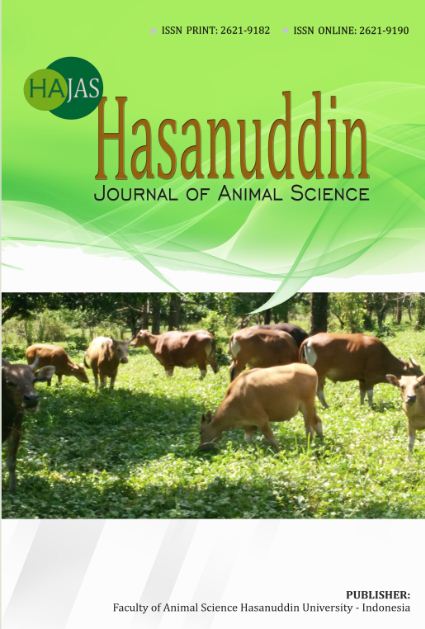Organoleptic Test Characteristics of Corn Stover Silage Added with Several Legumes
DOI:
https://doi.org/10.20956/hajas.v6i2.31778Abstract
The limited forage availability in the dry season is a limiting factor in a livestock business. The abundance of forage in the rainy season cannot be stored long without treatment. This is due to the high water content, so forage cannot be stored; there is a need for innovative feed technology. Silage is a feed processing technology using a method of preserving/fermenting feed in anaerobic conditions, which is placed in a silo with a water content of around 60-70%. The principle of forage fermentation is by microbes that produce a lot of lactic acid. This research aimed to determine corn straw silage's physical properties (organoleptic tests) by adding several types of legumes. According to data from the Directorate General of Animal Husbandry and Animal Health in 2022, the number of cattle in South Sulawesi Province was 18,610,000 head. The increase in production in 2022 compared to 2012 occurred in all regions in Indonesia, South Sulawesi Province. Corn produced was 1,420,154 tons, which shows that corn straw waste is abundant and can be used as forage using silage technology. The materials used are Bima Provit A1 (stay green), hybrid corn stover, and legumes. The treatments used were 95% corn stover silage (control), 70% corn stover silage + 25% Gamal legumes, 70% corn stover silage + 25% Lamtoro legumes, and 70% corn stover silage + 25% Indigofera legumes. Creating an acidic atmosphere can be accelerated by adding preservatives or additional ingredients (additives) to rice bran (5%). Organoleptic test parameters to determine silage's physical characteristics and quality, such as texture, color, and aroma. The results obtained were that the silage texture score in all treatments had an average value that was not much different and fell into the medium texture category, the silage color score in all treatments had good quality, brown and yellowish brown, the aroma score in all treatments had good quality.
Keywords: Corn stover silage, leguminosae, organoleptic test
Downloads
Published
Issue
Section
License

This work is licensed under a Creative Commons Attribution-NonCommercial 4.0 International License.











